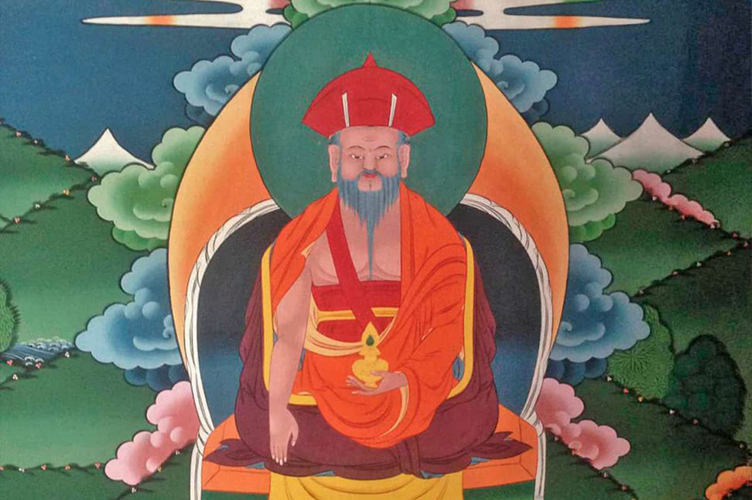Zhabdrung Ngawang Namgyel – Unifier of the Dragon Country

The Dzongs (fortified monastic edifices) that visitors to the country will inadvertently come across in every district are the legacy of one person – Ngawang Namgyal or the Zhabdrung (meaning ‘at whose feet one submits’) as he later came to be known as. To this day they serve as vivid reminders of the work that he carried out in order to unify the country.
The great Zhabdrung Ngawang Namgyel is widely regarded as the greatest historical figure of Bhutan, whose stature was not very far removed from that of an enlightened deity and is revered even today as such. A renaissance man blessed with abundant talents and virtues, he was the very embodiment of his former incarnation, the great Kuenkhen Pema Karpo.
The great Zhabdrung Ngawang Namgyel is widely regarded as the greatest historical figure of Bhutan, whose stature was not very far removed from that of an enlightened deity and is revered even today as such. A renaissance man blessed with abundant talents and virtues, he was the very embodiment of his former incarnation, the great Kuenkhen Pema Karpo.
A statesman, ruler and spiritual leader par excellence, his political and social initiatives and reforms changed the course of Bhutanese history and touched every aspect of the nation’s social and cultural fabric. The visionary experiences that he had unanimously directed him to build his Drukpa state by securing both spiritual and political power over the southern lands (Bhutan). Accordingly, he began to work towards becoming the spiritual and temporal ruler of Bhutan and rule over the many religious leaders and chieftains in the country. His arrival in Bhutan became a historical and political milestone. Cheri monastery, which he built to house the remains of his late father began a new chapter in the history of the Drukpa school in Bhutan. A monastic community consisting of some thirty monks was instituted at the monastery for the very first time. This was the beginning of his religious tradition which would come to be known as ‘Lhodruk’ or the southern Drukpa order. Perhaps, his most significant legacy for Bhutan, was that he gave shape to the country’s distinct national, social and cultural identity, which has always acted as an important safeguard for a small and vulnerable country in maintaining its sovereignty since the medieval ages to this day.
Though rightfully enthroned as the 18th Abbot of Ralung, a contentious claim by a rival contender, Pagsam Wangpo, as the authentic reincarnation and the ensuing disputes were to lead Ngawang Namgyel to leave Tibet to fulfill his prophesized destiny as the temporal and spiritual ruler of the southern Kingdom of Bhutan. On the invitation of his devout patrons from Bhutan, and given the auspicious omens and dreams he had of this southern country, he came to Bhutan in 1616. He is said to have had a vision of Mahakala (the patron deity of Bhutan) who offered him the whole of the southern land (Bhutan) and ensured him victory over the Tibetan forces. Zhabdrung’s south-ward journey into exile (to Bhutan) has been interpreted as a pre-ordained course of history, predicted by no less a figure that Guru Rimpoche (Padmasambhava) in the 8th century. He fled Tibet for Bhutan, bringing with him a vertebra relic - the ‘Rangjung Kharsapani’ (an image miraculously formed from Tsangpa Gyarey’s vertebra), which ended up as the main reason for the several Tibetan invasions that followed.
In a very short time after his arrival, the Zhabdrung repelled several Tibetan invasions and effectively consolidated his authority in Western Bhutan. At the end of his reign, the Zhabdrung had unified a great part of the country for the first time under a central theocratic government. This was largely achieved through establishing a network of strategically located Dzongs, the setting up of central political and administrative machinery along with the formalization of the Drukpa Kagyu School as the state religion and ideology. The Dzongs enabled him to gain control over different regions of the country. The success of the process of unification and the many other accomplishments and extraordinary feats he performed, resulted in him earning the appellation ‘Zhabdrung’ which translates as ‘At Whose Feet one Submits.’
Though rightfully enthroned as the 18th Abbot of Ralung, a contentious claim by a rival contender, Pagsam Wangpo, as the authentic reincarnation and the ensuing disputes were to lead Ngawang Namgyel to leave Tibet to fulfill his prophesized destiny as the temporal and spiritual ruler of the southern Kingdom of Bhutan. On the invitation of his devout patrons from Bhutan, and given the auspicious omens and dreams he had of this southern country, he came to Bhutan in 1616. He is said to have had a vision of Mahakala (the patron deity of Bhutan) who offered him the whole of the southern land (Bhutan) and ensured him victory over the Tibetan forces. Zhabdrung’s south-ward journey into exile (to Bhutan) has been interpreted as a pre-ordained course of history, predicted by no less a figure that Guru Rimpoche (Padmasambhava) in the 8th century. He fled Tibet for Bhutan, bringing with him a vertebra relic - the ‘Rangjung Kharsapani’ (an image miraculously formed from Tsangpa Gyarey’s vertebra), which ended up as the main reason for the several Tibetan invasions that followed.
In a very short time after his arrival, the Zhabdrung repelled several Tibetan invasions and effectively consolidated his authority in Western Bhutan. At the end of his reign, the Zhabdrung had unified a great part of the country for the first time under a central theocratic government. This was largely achieved through establishing a network of strategically located Dzongs, the setting up of central political and administrative machinery along with the formalization of the Drukpa Kagyu School as the state religion and ideology. The Dzongs enabled him to gain control over different regions of the country. The success of the process of unification and the many other accomplishments and extraordinary feats he performed, resulted in him earning the appellation ‘Zhabdrung’ which translates as ‘At Whose Feet one Submits.’
